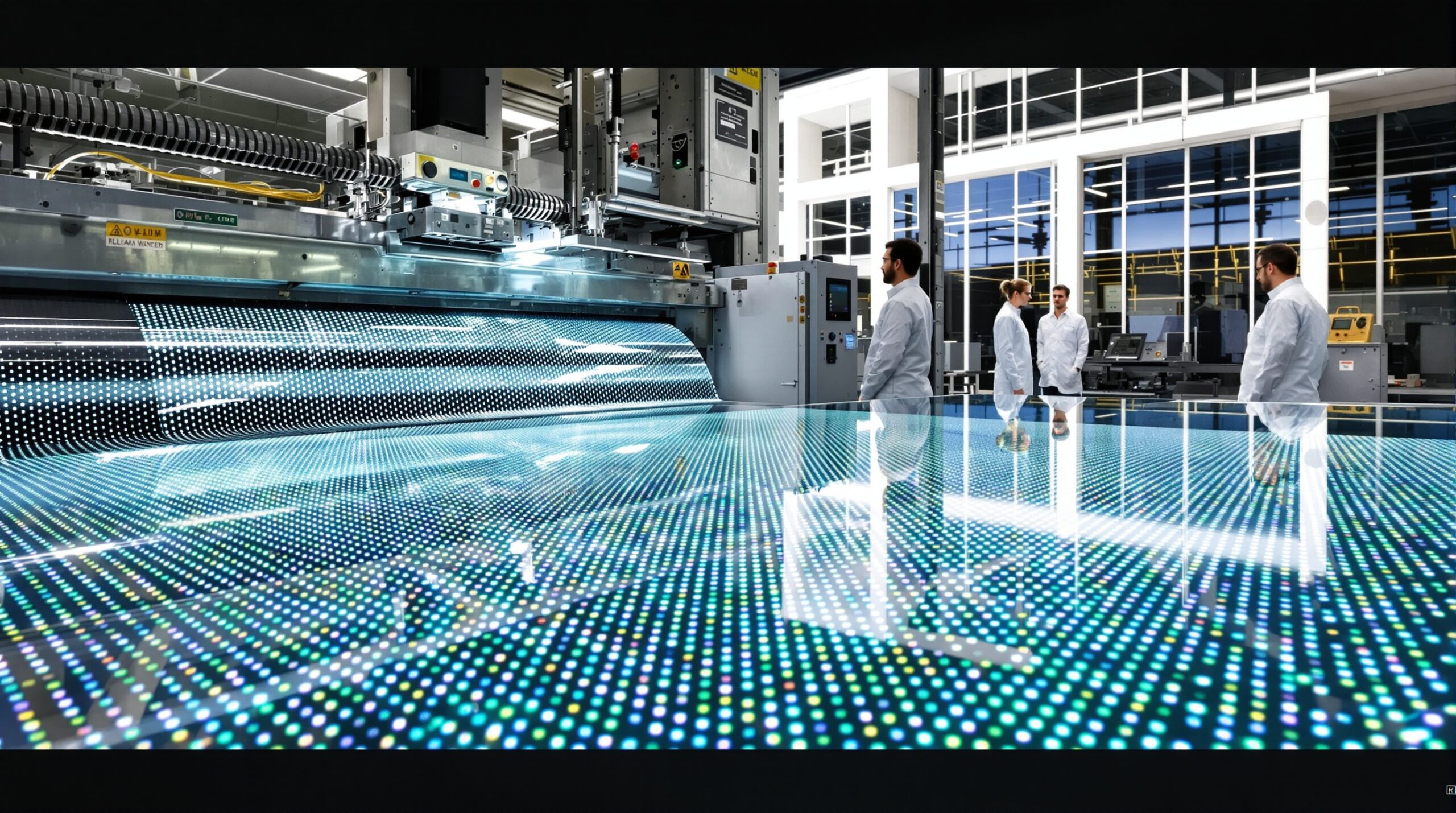Quantum dot inks are unlocking printable solar windows for energy-harvesting buildings. These coatings convert sunlight while preserving visibility, enabling electricity from ordinary glass. They integrate photovoltaics directly into facades, skylights, and atriums with minimal aesthetic compromise. As a result, building envelopes start working like distributed power plants.
Researchers and companies have progressed from lab samples to pilot installations. The move reflects advances in materials, printing, and encapsulation technologies. Together, these improvements address performance, durability, and manufacturability challenges. Therefore, the path toward scalable architectural deployment is becoming clearer.
What are quantum dot inks?
Quantum dots are semiconductor nanocrystals with size-tunable optical and electronic properties. Their dimensions confine electrons, creating discrete energy levels and tunable bandgaps. By controlling size and composition, scientists tune absorption and emission wavelengths. This tunability underpins their role in spectrally selective solar windows.
Quantum dot inks disperse these nanocrystals in solvents with stabilizing ligands. Formulators tailor viscosity, surface tension, and drying to suit printing methods. Additives control film formation, aggregation, and compatibility with downstream layers. Balanced formulations yield uniform coatings across large, architectural substrates.
How printable solar windows work
Most concepts use luminescent solar concentrators integrated into window laminates. Quantum dots absorb sunlight and re-emit shifted light within a waveguide. The waveguide channels photons to edge-mounted photovoltaic cells for conversion. This approach preserves visible transparency while harvesting otherwise wasted wavelengths.
Another strategy deposits semi-transparent photovoltaic stacks with quantum dot absorbers. Such devices harvest near-infrared light and maintain human-visible transparency. Optimized stacks reduce reflection and resist haze to keep views clear. Consequently, architects can prioritize daylight while delivering meaningful energy yield.
Spectral selectivity and aesthetics
Spectral selectivity is crucial for occupant comfort and design freedom. Quantum dots offer narrow emission and tunable absorption across the solar spectrum. Engineers often target ultraviolet and near-infrared absorption, sparing visible wavelengths. That strategy maintains color neutrality and high visible transmittance.
Large Stokes shifts reduce reabsorption losses and preserve transparency at scale. Core-shell structures enhance quantum yield while improving photostability. Proper dot selection minimizes tint and preserves natural daylight color. Therefore, installations blend with both heritage facades and modern glazing systems.
Manufacturing and printing methods
Printable windows rely on established coating and patterning techniques. Inkjet, slot-die, gravure, and spray processes deposit films over square meters. Low-temperature processing supports polymers, glass interlayers, and tempered glass. Roll-to-roll lines enable high throughput with precise thickness control.
Layer stacks include adhesion promoters, quantum dot layers, and barrier coatings. Ligand exchange improves charge transport where dots contact charge-collecting layers. Encapsulants block oxygen and moisture while resisting ultraviolet exposure. As a result, modules survive weathering across diverse climates.
Performance metrics
Performance depends on visible transmittance, color rendering, and power conversion efficiency. Higher transparency generally reduces energy yield, establishing a design tradeoff. Architects often target 50% to 70% visible transmittance for occupied spaces. Glare control and daylight goals further guide optical specifications.
Reported effective power densities remain lower than opaque rooftop photovoltaics. Demonstrations often deliver roughly 5 to 20 watts per square meter. Values depend on orientation, glazing stack, and coupling efficiency to edge cells. Even modest output offsets plug loads and building automation energy use.
Waveguide optics influence performance under varying sun angles and diffuse light. Quantum dots can harvest diffuse skylight efficiently due to isotropic absorption. Anti-reflection coatings and textured interfaces reduce escape cone losses. Therefore, optimized optics improve yield without sacrificing transparency.
Stability and durability
Durability remains a central challenge for building applications. Quantum dots can degrade by photooxidation, ligand detachment, and moisture ingress. Core-shell architectures and barrier films mitigate these degradation pathways. Accelerated aging tests guide materials selection and encapsulation design choices.
Standards testing includes ultraviolet exposure, thermal cycling, and damp heat. Manufacturers pursue multi-year stability with minimal color shift and efficiency loss. Edge seals, desiccants, and UV-blocking interlayers extend service life. Consequently, reliability is improving toward conventional glazing expectations.
Building integration and energy outcomes
Solar windows complement building-integrated photovoltaics across roofs and spandrel panels. They supply distributed power for lighting, sensors, shades, and facade actuators. Direct current microgrids can use harvested energy with minimal conversion losses. Therefore, windows support resilient loads even during grid disruptions.
Glazing choice affects heating, cooling, and lighting loads throughout the year. Quantum dot layers can lower solar heat gain while maintaining daylight. That combination reduces peak cooling demand and improves occupant comfort. Integration with smart glass further optimizes dynamic building performance.
Safety and environmental considerations
Material selection must address health, safety, and environmental regulations. Some high-performance dots contain cadmium or lead, triggering stricter controls. Alternatives include indium phosphide and copper indium sulfide formulations. Robust encapsulation reduces potential exposure during use and maintenance.
Compliance frameworks include RoHS, REACH, and local building codes. Manufacturers document restricted substance content and conduct leach testing. End-of-life strategies prioritize reuse, recycling, and responsible material recovery. Therefore, circular design reduces lifecycle environmental impacts.
Economics and market considerations
Cost per square meter remains the key commercial hurdle. Printing lowers capital intensity compared with vacuum deposition photovoltaics. However, yields, uniformity, and color consistency must meet facade standards. Independent certification and bankability will drive broader procurement confidence.
Research directions
Researchers pursue larger Stokes shifts to suppress reabsorption losses. Energy transfer cascades and heterostructures can route photons more efficiently. Printing research targets faster lines and in-line quality control. Consequently, manufacturing maturity continues to advance across the supply chain.
Outlook and applications
Early deployments appear in transit hubs, atriums, and corporate campuses. Retrofit films demonstrate value without replacing existing insulated glazing units. Greenhouses test spectral shaping while generating auxiliary power for automation. These applications build confidence for wider commercial adoption.
Conclusion
Quantum dot inks make solar windows printable, scalable, and architecturally flexible. They harvest sunlight while maintaining transparency, color quality, and visual comfort. Continued progress in materials, optics, and manufacturing will raise performance. With proven durability, buildings can turn glass into productive energy assets.


